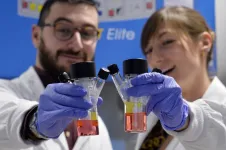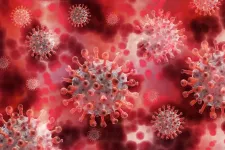Researchers find the adhesions that build the brain's networks
An important clue to several maladies, including epilepsy and autism spectrum disorders
2021-06-24
(Press-News.org) DURHAM, N.C. - The brain's neurons tend to get most of the scientific attention, but a set of cells around them called astrocytes - literally, star-shaped cells - are increasingly being viewed as crucial players in guiding a brain to become properly organized.
Specifically, astrocytes, which form about half the mass of a human brain, seem to guide the formation of synapses, the connections between neurons that are formed and remodeled as we learn and remember.
A new study from Duke and UNC scientists has discovered a crucial protein involved in the communication and coordination between astrocytes as they build synapses. Lacking this molecule, called hepaCAM, astrocytes aren't as sticky as they should be, and tend to stick to themselves rather than forming connections with their fellow astrocytes.
This finding, in studies on mice with the gene for hepaCAM knocked out of their astrocytes, is an important clue in efforts to understand several brain disorders, including cognitive decline, epilepsy and autism spectrum disorders. The work appears June 24 in the journal Neuron.
A rare disorder called megalencephalic leukoencephalopathy (MLC) is also known to be caused by a mutation in the hepaCAM gene, and this work might provide answers about what exactly has gone wrong. MLC is a developmental disorder that grows progressively worse, causing macrocephaly (a large head), swelling of the brain's white matter, intellectual disability and epilepsy.
By removing hepaCAM selectively from astrocytes to see what it does, "we sort of made the cells into introverts," said senior author Cagla Eroglu, an associate professor of cell biology at the Duke University School of Medicine. "They're normally wanting to reach out, but without hepaCAM, they started to hug themselves instead."
"If the astrocyte makes junctions to its neighbors, then you start to have a network," Eroglu said. "To make a functional brain, you need a functional astrocytic network."
The researchers zeroed in on hepaCAM by looking for genes that are highly active in astrocytes and which have been implicated in brain dysfunction. They partnered with another group working on hepaCAM at the University of Barcelona, but that group has been looking at the molecule for its role in regulating chloride signaling channels in astrocytes.
The Duke group found that removing hepaCAM from astrocytes led to a synaptic network that was too easily excited and not as well dampened. "The effect on the inhibitory synapses was the strongest," said first author Katie Baldwin, who recently became an assistant professor of cell biology and physiology at the University of North Carolina at Chapel Hill. "You're putting the inhibition down and the excitation up, so that really could point to a mechanism for epilepsy."
Baldwin, who did this work as a postdoctoral researcher in Eroglu's lab, is planning to further pursue these questions in her new lab at UNC, testing whether hepaCAM-deficient mice behave differently or have changes in learning and memory, or whether they exhibit the stress and social anxiety that are markers of autism spectrum disorders. She said they might also reintroduce the disease-mutation versions of the protein to mice that were born without it to see what effects it has.
"We know hepaCAM is interacting with itself between two astrocytes, but we don't know what it's interacting with at the synapse," Baldwin said. "We don't know if it could be interacting with hepaCAM which is also found in the neurons, or if it could be some other protein that we don't know about yet."
INFORMATION:
This research was supported by the U.S. National Institutes of Health (R01DA047258, R01NS102237, F32 NS100392), Foerster-Bernstein Family, The Hartwell Foundation, and the European Research Council (725780 LinPro).
CITATION: "HepaCAM Controls Astrocyte Self-Organization and Coupling," Katherine Baldwin, Christabel Tan, Samuel Strader, Changyu Jiang, Justin Savage, Xabier Elorza-Vidal, Ximena Contreras, Thomas Ruelicke, Simon Hippenmayer, Raul Estevez, Ru-Rong Ji and Cagla Eroglu. Neuron, June 24, 2021. DOI: 10.1016/j.neuron.2021.05.025
ELSE PRESS RELEASES FROM THIS DATE:
2021-06-24
GRAND RAPIDS, Mich. (June 24, 2021) -- The same taste-sensing molecule that helps you enjoy a meal from your favorite restaurant may one day lead to improved ways to treat diabetes and other metabolic and immune diseases.
TRPM5 is a specialized protein that is concentrated in the taste buds, where it helps relay messages to and from cells. It has long been of interest to researchers due to its roles in taste perception and blood sugar regulation.
Now, a team led by scientists at Van Andel Institute has published the first-ever high-resolution images of TRPM5, which reveal two areas that may serve as targets for new medications. The structures also may aid in the development of low-calorie alternative sweeteners that mimic sugar. The findings were published today in Nature ...
2021-06-24
BELLINGHAM, Washington, USA - The open access Journal of Astronomical Telescopes, Instruments, and Systems (JATIS) has published END ...
2021-06-24
The study was conducted by an international collaboration involving the research team led by Luca Tiberi of the Armenise-Harvard Laboratory of Brain Cancer at the Department of Cellular, computational and integrative biology - Cibio of UniTrento, the Paris Brain Institute-Institut du Cerveau at Sorbonne Université in Paris, the Hopp Children´s Cancer Center (KiTZ) in Heidelberg, Germany, and Sapienza University in Rome. It was supported by Fondazione Armenise-Harvard, Fondazione Airc (Italian Association for Cancer Research) and Fondazione Caritro from Trento. The findings of the study, published in Science Advances, could lead to better and more effective treatments.
The team of researchers is proud of the results achieved. Luca Tiberi, coordinator of the study and corresponding ...
2021-06-24
Dmitry Blinov is a co-author of the article and Senior Research Associate in the Department of Astrophysics, St Petersburg University. He notes that researchers have been studying the optical polarisation from active galactic nuclei for more than 50 years. Some of the first academic papers on this topic were published back in the 1960s by Vladimir Hagen-Thorn, Professor in the Department of Astrophysics, St Petersburg University, and Viktor Dombrovskiy, Associate Professor in the Department of Astrophysics, Leningrad State University.
In the Universe, the main material is concentrated in galaxies with hundreds of billions of stars: there are about 200-400 of them in the Milky Way. At the centre of galaxies there are supermassive ...
2021-06-24
An international team of researchers co-led by the University of Adelaide and the University of Arizona has analysed the genomes of more than 2,500 modern humans from 26 worldwide populations, to better understand how humans have adapted to historical coronavirus outbreaks.
In a paper published in Current Biology, the researchers used cutting-edge computational methods to uncover genetic traces of adaptation to coronaviruses, the family of viruses responsible for three major outbreaks in the last 20 years, including the ongoing pandemic.
"Modern human genomes contain evolutionary ...
2021-06-24
Rheumatologists are familiar with the everyday use of immunomodulatory drugs. These are designed to treat the inflammation caused by autoimmune diseases such as rheumatoid arthritis. A EULAR taskforce was set up to develop a set of new points to consider to give guidance and advice on the best way to use these medicines to treat COVID-19. The taskforce included rheumatologists, immunologists, haematologists, paediatricians, patients and other health professionals. They looked at the published evidence on the use of immunomodulatory therapies to treat severe COVID-19.
In total, there are two overarching principles and 14 points to consider. The principles stress that the picture of SARS-CoV-2 infection can be very different in different people. Infections range from asymptomatic ...
2021-06-24
Measuring ethane in the atmosphere shows that the amounts of methane going into the atmosphere from oil and gas wells and contributing to greenhouse warming is higher than suggested by the U.S. Environmental Protection Agency, according to an international team of scientists who spent three years flying over three areas of the U.S. during all four seasons.
"Ethane is a gas that is related only to certain sources of methane," said Zachary R. Barkley, researcher in meteorology and atmospheric science, Penn State. "Methane, however, is produced by oil, ...
2021-06-24
Understanding work participation is important, but the way in which this is defined and measured in clinical trials is not always the same, which has made it hard to compare data. EULAR set up a taskforce to draft points to consider when designing studies that use work participation as a measure. The taskforce included doctors, experts and patients from 11 countries. They used the published evidence to draw up a set of points to consider.
Two overarching principles and nine points to consider were developed. The principles say that work participation is important for people with inflammatory arthritis, their ...
2021-06-24
Paper Title: Analysis of Common Shoulder Injuries in Collegiate Baseball Players
Journal: The Physician and Sportsmedicine (June 23, 2021, online edition)
Authors: Alexis Chiang Colvin, MD, Professor, Department of Orthopedic Surgery at the Icahn School of Medicine at Mount Sinai; Daniel A. Charen, MD, Resident, Department of Orthopedic Surgery at the Icahn School of Medicine at Mount Sinai; and other coauthors.
Bottom Line: Baseball players are highly susceptible to shoulder injuries due to significant microtrauma including repetitive overhead throwing. Mount Sinai researchers investigated men's National Collegiate ...
2021-06-24
Fibromyalgia is one of many chronic pain conditions that remains stubbornly difficult to treat.
As the ravages of the opioid epidemic lead many to avoid these powerful painkillers, a significant number of people with fibromyalgia are finding an effective replacement in CBD-containing products, finds a new Michigan Medicine study.
CBD, short for cannabidiol, is the second most common cannabinoid in the cannabis plant, and has been marketed for everything from mood stabilization to pain relief, without the intoxicating effects produced by the most common cannabinoid, THC. THC, which stands for ...
LAST 30 PRESS RELEASES:
[Press-News.org] Researchers find the adhesions that build the brain's networks
An important clue to several maladies, including epilepsy and autism spectrum disorders



